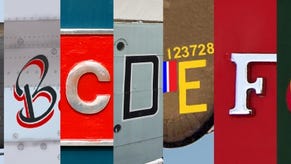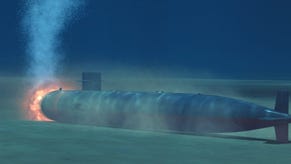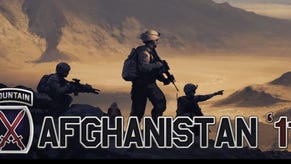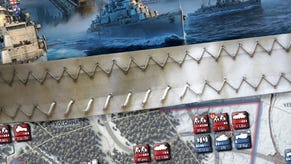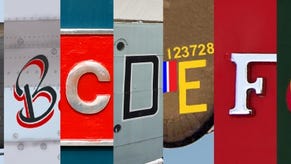Wot I Think: Afghanistan 11
FOB watch
Let's see if I can get through this without using the W word. Afghanistan 11 is a w****** (history-steeped military strategy game with influential terrain and plausible, reality-derived unit relationships) but it would be a tragedy if w******* (habitual users of history-steeped military strategy games with influential terrain and plausible, reality-derived unit relationships) were the only people who ever stumbled into its quicksand. The W word, especially when used in close proximity to hexy screenshots, tends to imply threadbare themes and moribund mechanics. It doesn't generally suggest a game with the irresistible momentum of Civ, or the colourful intricacy of Tropico. A game like the quietly brilliant Afghanistan 11.
Designer Johan Nagel begins by handing us all the biggest and best military toys. We get the drones, the F-16s, the A-10s, the Apaches, and the M777 howitzers while our AI opponents – the warlord militia and Taliban – must make do with technicals, AK-47s, RPGs, and homemade explosives. Johan then proceeds to explain, through a host of simple yet ingenious rules and play elements, why sophisticated tech and a ludicrous firepower advantage have never guaranteed victory in The Graveyard of Empires.
In a war zone where enemy cadres either emerge from impossible-to-find caves to plant IEDs and intimidate villagers (militia behaviour) or infiltrate from the eastern map edge - Pakistan - staging ambushes, sabotaging infrastructure, and harassing vulnerable bases, before slipping back whence they came (Taliban behaviour), marching around Napoleon-like at the head of an intimidating army is pointless. Completely eradicating the foe in open battle is impossible. The most you can hope to do is restrict their operations, and persuade their willing and unwilling sustainers, the villages dotting every map, to forsake them.
Hearts and Minds are won with a sage mix of vigilance, diligence, aid and violence. Regular village visits build loyalty. Nearby victories, infrastructure improvements, and IED clearing operations cement it. Eventually the locals are confident enough to start sharing information. Yesterday we saw a group of armed strangers digging a hole next to the bridge... My brother-in-law told me there's a party of foreign fighters camped in the hills south of the main highway. In an environment where locating a maddeningly elusive enemy is half the battle, these tip-offs are gold dust.
But gold dust that will trickle through your fingers unless you possess the network of Forward Operating Bases (FOBs) necessary to mount swift, effective counter-insurgency actions. Where other logistically minded battle sims are happy to accept wiggles of controlled hexes between units and depots as functioning supply lines, A11 asks us to plot and oversee every ration, ammo and fuel delivery in person. It's rare for a turn to pass without at least one supply-related jaunt commencing or concluding. Hmm, my mortar battery at FOB Alpha desperately needs bombs. I'd use my Chinook to courier them over but it's currently porting fuel to that Buffalo engineering vehicle constructing a waterworks at Marjah, so it looks like I'll have to risk a truck dash along the Malgir highway, or 'Ambush Alley' as I call it.
This constant shuttling of supplies, combined with modular FOB construction, and unit purchasing (units are bought with Political Points, a fluctuating form of income impacted by many of the same activities that effect the local and national Hearts and Minds score) often make Afghanistan 11 feel more like Anno or Industry Giant, than Panzer Corps or Battle Academy. It could be tiresome, but almost never is because of sly, unpredictable enemies that like nothing better than preying on fat fuel tankers or helos dangling vital sling loads. Some of the game's tensest and most satisfying moments centre on logistics. Blunting a major Taliban attack with a judicious mix of airpower and artillery? Highly gratifying. Watching a battered long-distance convoy limp into a FOB that has been cut-off and fighting for its life for several turns? Priceless.
None of the above is likely to come as a great surprise to owners of Vietnam 65, A11's mechanically similar forerunner. What should startle and heartwarm however, is the way Johan has enmeshed entirely new components – components that add flavour and enrich an already dense decision space – without miring pace or mortgaging approachability. I'm talking primarily about elections, handover and events cards.
Handover is a feature worthy of an Alex Wiltshire 'The Mechanic' article. Where in V65, Special Forces-trained local troops were merely an economical way to enlarge and deepen your military bootprint, in A11 - especially late-game - they are essential to success. On turn 50 of a standard 60-turn random-map skirmish game, the vast majority of US units on the map file into capacious C-17 transport aircraft and, breathing weary sighs of relief, head for home. Your network of bases are taken over by the Afghanistan National Army troops you've been recruiting and battle-hardening over the past four to six hours. With a wonderfully bold flourish of his designer's wand, Nagel distills complicated history and ensures the closing phases of games are turbulent and testing.
The tempo of play is also impacted by periodic elections. Whether the candidates you back end-up victorious in these is heavily dependent on your H&M performance during the five turns before ballots. While you scurry about buying votes with aid deliveries, road construction, and (if all goes to plan) combat successes, you can be certain that out of sight there are dusty wraiths with spades and AK-47s just as busy.
A weaker design would rely on event cards to inject excitement or fill thematic gaps. In A11 the cards, presented as newspaper headlines, merely nudge and remind. There are things happening in Washington and Kabul that you can't hope to influence. Process the change, be it a shift in unit cost, PP income, H&M or whatever, and, bearing it in mind, get back to work. Helo-hampering sandstorm turns are foreseeable (they're marked on the strat-map screen along with a wealth of useful info about village allegiances and enemy activity) but invite the same sort of stoicism.
Vietnam 65 was campaignless, relying, justifiably I felt, on a powerful random-map skirmish mode for replayability. The sequel sports a similarly excellent skirmish mode but also boasts a sequence of 18 historically-based outings (configurable difficulty settings means no-one should get hopelessly stuck while moving through these). We get recognisable maps and cunningly customised victory conditions. Less positively we also get austerity briefings, ISAF lip-service, and the odd weak attempt at simulating small-scale Special Forces missions. Discovering that the British forces mentioned in one mission intro, wore the same uniforms, operated the same vehicles, and spoke in the same accents as US ones, was disappointing. Better no Brits, Canadians, Germans etc than token, characterless ones? I think so.
Although I'm not holding my breath for a free update with Jackals, Mastiffs, and Merlins, I am hopeful Every Single Soldier/RetroEpic Software will do something about minor irritants like the very limited save facilities, occasionally annoying aircraft animations, and absence of an undo button, in the weeks to come. There's currently only two save slots (one for skirmish, one for campaign) no way to correct accidental moves, and leafing through units is a little more laborious than it needs to be because based helos insist on rising into the air before accepting commands.
And if a future patch added a 'chance of civilian casualties' tickbox to the difficulty settings I hope I'd have the honesty to use it. A11's representation of opium production is refreshingly mature and nuanced (destroying poppy fields damages the Taliban, boosts PP income, but erodes local H&M), something that can't be said for its representation of air strikes near settlements, none of which ever have negative H&M consequences.
Whatever happens to Afghanistan 11 in the future, it's sure to be one of my most played w******* (history-steeped military strategy games with influential terrain and plausible, reality-derived unit relationships) this year. I love how it forces me to spin plates. I like the way it uses IEDs and RPGs to transform every vehicle move into an adventure. In a genre dominated by demolition and death, the emphasis it places on construction, and improving the lives of the local populace, is cheeringly discordant. The theme isn't one I'm naturally drawn to, but the design is so strong, the history so ingeniously utilized, an 'RPS Recommended' rosette is inevitable.
Afghanistan 11 is available now priced around £21
















